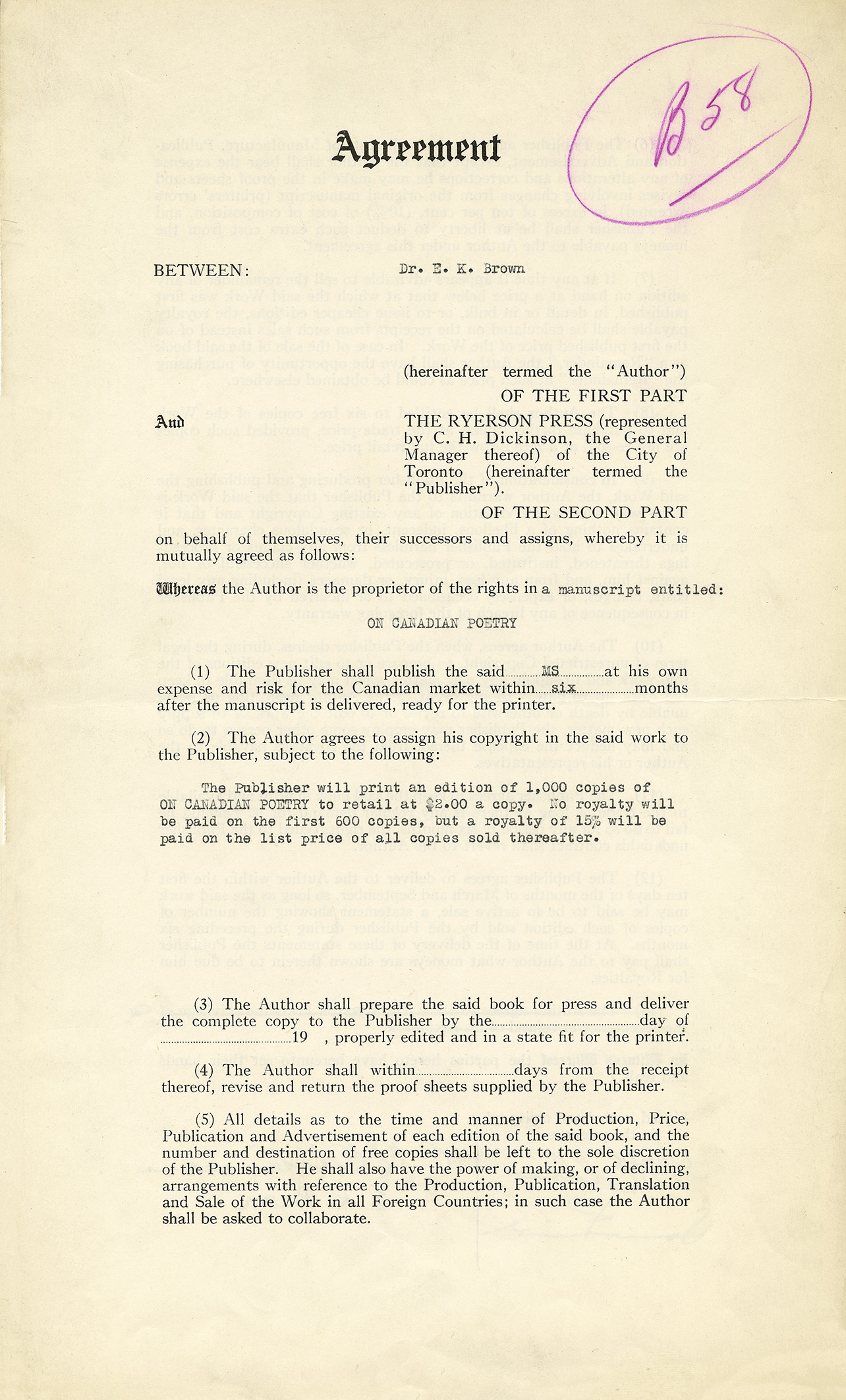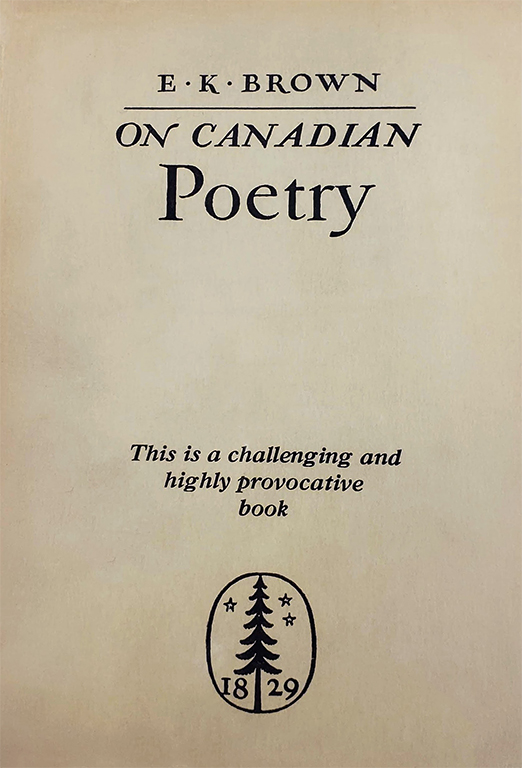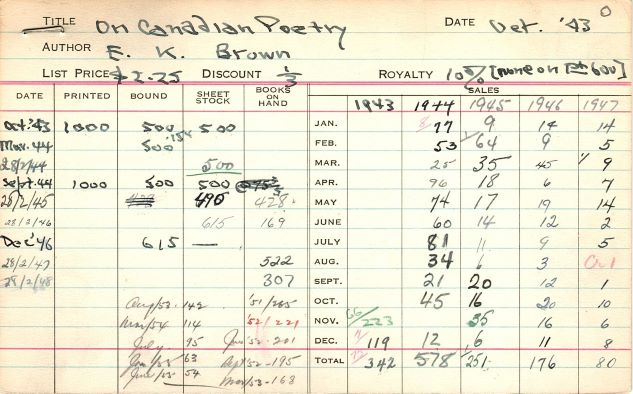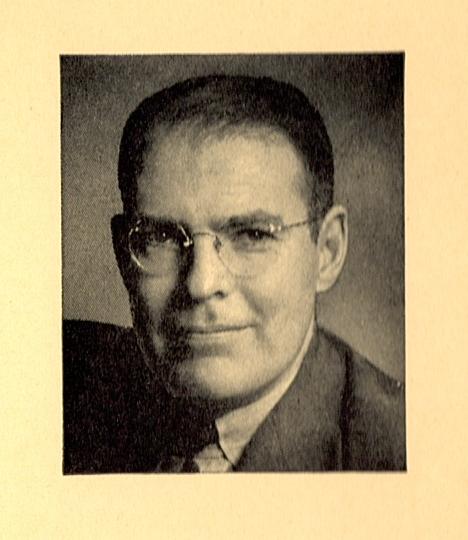Edward Killoran Brown, better known as E.K. Brown (1905-1951), was a well-known Canadian professor and literary critic who received the Governor General’s Literary Award for his most influential work, On Canadian Poetry, published by Ryerson Press in 1943 (revised 1944). Brown was the first modern Canadian critic to “establish a context for the study of 19th- and 20th-century Canadian poetry by identifying Canada’s major poets (Archibald Lampman, D.C. Scott and E.J. Pratt), tracing their influences and closely defining the strengths of their verse.”1
In 1926, Brown graduated from the University of Toronto with the Governor General’s Medal for Modern Languages and a scholarship to the Sorbonne (University of Paris),2 where he obtained a docteur-ès-lettre in 1935.3 He taught English at the University of Toronto from 1929 to 1941, except for the two-year period 1935 to 1937, when he was chair of the English Department at the University of Manitoba. From 1941 to 1944, Brown was chair of the English Department at Cornell University. For six months in 1942, he also served as speechwriter to Prime Minister William Lyon Mackenzie King. From 1944 until his death in 1951, he was chair of the English Department at the University of Chicago. For “achievement of special significance and conspicuous merit in imaginative or critical literature written in either English or French,”4 Brown was posthumously awarded the Royal Society of Canada’s Lorne Pierce Medal.

Brown was a prolific scholar who published in French and English. Among his many works were Edith Wharton, étude critique (1935) and Studies in the Text of Matthew Arnold’s Prose Works (1935). He was co-editor (with Duncan Campbell Scott) of Archibald Lampman’s At the Long Sault and Other New Poems (Toronto: Ryerson Press, 1943) and editor of Duncan Campbell Scott’s Selected Poems (Toronto: Ryerson Press, 1951). Brown also translated works from French to English, including Louis Cazamian’s Carlyle (1932) and Balzac’s “Père Goriot” (1946). In addition, Brown was a periodical editor. From 1930 to 1933, he was associate editor of the Canadian Forum and contributed over fifty articles and essays to the journal. From 1932 to 1941, he was editor of the University of Toronto Quarterly; with A.S.P. Woodhouse, Brown spearheaded “Letters in Canada,” the Quarterly’s annual bilingual survey of Canadian literature.
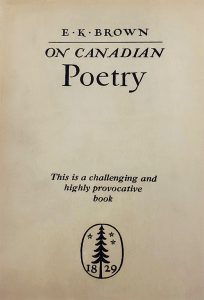
In 1943, Ryerson Press published Brown’s On Canadian Poetry in an edition of 1000 copies. Thoreau MacDonald, an illustrator, designer, and painter whose artwork often appeared in Ryerson Press books, designed the volume.5 The cover proclaimed, “This is a challenging and highly provocative book,”6 while the inside dust jacket noted that “no critical essay on Canadian letters so important as this book has appeared since The White Savannahs, by W.E. Collin.”7 Indeed, Brown’s argument – that Canada needed to develop a distinct national literature, separate from the UK and the US – departed from the prevailing view of Canadian literature as inferior to both British and American literature.
In his preface to the first edition, Brown claims On Canadian Poetry “is not a historical enquiry but a critical essay.”8 Chapter one presents some of the problems facing Canadian literature, while chapter two examines the development of poetry in Canada. He concludes the volume with a chapter dedicated to the masters of Canadian poetry, per Brown: Archibald Lampman, Duncan Campbell Scott, and E.J. Pratt. On Canadian Poetry won the praise of A.J.M. Smith. In his 1944 review of the book, Smith explains that the barriers placed in the way of the Canadian writer “by his social, economic, and cultural environments … [are] Canada’s subservience to British and American publishing markets, her pioneer inheritance of a narrow practicality and a puritan reticence, her regional loyalties, and her colonial attitude of mind.” Smith goes on to laud Brown’s achievement, citing him as one of the reasons why “Canadians are becoming more intelligently aware of” Canadian literature.9
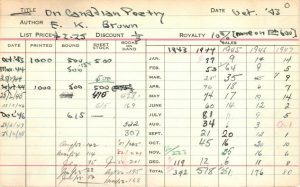
On Canadian Poetry was well received, so much so that just one year after its initial publication, Ryerson Press released a revised edition, also of 1000 copies. In a preface to the revised edition, Brown lists the changes he made to his original text. To chapter one, he added a “brief passage on the role of national crisis in the development of literature.”10 Chapter two included an account of recently published poetry and a revised section on Lampman, which references his lecture “Two Canadian Poets.” Finally, at the end of the volume, Brown appended a brief timeline of significant dates.
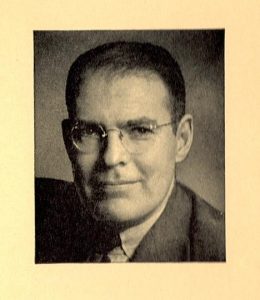
Brown’s work, however influential, was not impartial. In fact, it was “largely responsible for the current general view that … [Lampman, Scott, and Pratt] are the major figures of the era, and that Charles G.D. Roberts and Bliss Carman are of less importance.”11 This was, after all, Brown’s intention. As he admitted in a letter to Scott: “Our literary history must be rewritten, and some of the landmarks removed. Carman and Roberts will no longer do as landmarks. I think that A.L. [i.e., Archibald Lampman], and you and Ned [E.J.] Pratt will do, and that you three must be the main landmarks.”12 It is no secret that Brown cherry-picked his favourite authors – who also were among his close friends – to showcase in his critical study. Given his influence, Brown’s deliberate foregrounding of poets Lampman, Scott, and Pratt as “the main landmarks” and his exclusion of other poets like Carman and Roberts from On Canadian Poetry, invariably shaped Canada’s literary canon.
Contemporary readers also should be aware of other cultural values implicit in Brown’s text. Not only does he consider white male authors as the three masters of Canadian poetry – an idea that holds little ground today – he also completely effaces authors like E. Pauline Johnson (whose dual Mohawk-English heritage informed her poetry and popular performances) from the Canadian canon. Brown himself was aware that his work was not all encompassing. As he acknowledged in his bibliographical note, “there is no wholly satisfactory history of Canadian literature or of Canadian poetry; those that are sufficiently comprehensive lack critical insight, and those with such insight are too restricted in scope.”13
Despite its limitations, On Canadian Poetry changed the face of Canadian literature and its criticism. According to Northrop Frye, Brown’s work was “the most clearly defined context within which to study Canadian literature.”14 Brown’s overview and analysis of Canadian poetry – driven by a desire to educate and elucidate – produced a work of profound and lasting influence.
1 Neil Besner, “E.K. Brown,” Canadian Encyclopedia. https://www.thecanadianencyclopedia.ca/en/article/ek-brown. See Laura Smyth Groening’s definitive biography, E.K. Brown: A Study in Conflict (Toronto: U of Toronto P, 1993).
2 Douglas Bush, “E.K. Brown and the Evolution of Canadian Poetry,” Sewanee Review 1979. www.jstor.org/stable/27543523.
3 The French equivalent of a PhD.
4 For more on this award, see Royal Society of Canada, Medals and Awards, http://rsc-src.ca/en/institutional-members/medals-awards/rsc-medals-awards#Pierce.
5 For more on MacDonald, see Joan Murray, “Thoreau MacDonald,” Canadian Encyclopedia. https://www.thecanadianencyclopedia.ca/en/article/thoreau-macdonald.
6 E.K. Brown, On Canadian Poetry (Toronto: Ryerson Press, 1943) dust jacket.
7 Brown, inside dust jacket. See W.E. Collin, The White Savannahs (Toronto: Macmillan Company of Canada, 1936).
8 Brown viii.
9 A.J.M. Smith, Review of On Canadian Poetry, by E.K. Brown; Sir Charles G.D. Roberts: A Biography, by E.M. Pomeroy; and Wilfred Campbell: A Study in Late Provincial Victorianism, by Carl Frederick Klinck, Canadian Historical Review 25.2 (June 1944): 196.
10 Brown viii.
11 Besner.
12 Robert L. McDougall, ed., The Poet and the Critic: A Literary Correspondence Between D.C. Scott and E.K. Brown (Ottawa: Carleton UP, 1983) 70.
13 Brown 153.
14 Besner.





